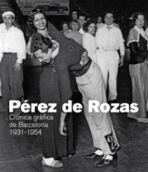Carlos Pérez de Rozas
grupo autores
A polite and conservative person, dedicated one hundred percent to his work, Carlos Pérez de Rosas Masdeu was the founder and patriarch of one of the most important photo-journalistic dynasties of this profession's history in Barcelona. Born in Madrid in 1893, at the heart of an upper class family very closely connected to intellectual, political and military circles, he started to work at an age of 17 at the newspaper Las Noticias, where he carried out all sorts of assistant tasks.
In 1913 unexpectedly he became a photographer when he managed to publish one of his photos of a warship that had been sunken in the Mediterranean Sea on the front page of the newspaper ABC. In a matter of few months he extended his list of clients, publishing in the sports magazine Stadium -he signed Rozas- as well as the Catholic magazine La Hormiga de Oro.
During the decade of 1920es his career went away from the photo-journalistic work while at the same time it took on a final push. The Marqués de Foronda, the chief executive officer of the International Exposition of 1929, hired him as the official photographer of the event, and he asked him to carry out an exhaustive monitoring of the urban transformation that was put in practise. Day after day his machine was witness and notary to the emergence of a new city model. The thousands of photos that he took during this period were integrated into the collection of the Arxiu Històric de la Ciutat, making up the most important fund preserved of the 1929 Expo. During the macro event, Pérez de Rozas was also very successful as portraitist and at the beginning of the decade of 1930es he started his own business entering a partnership with his friend Joan Andreu Puig Farran with who he opened up a photographic studio in La Rambla.
The announcement of the Republic in 1931 weakened his areas of influence considerably and the amount of assignments was reduced significantly from one day to the other. Nonetheless, the photographer managed to re-enter the City Council and started to work at El Día Gráfico where he would practise as a reporter to the fullest.
In the pages of El Día Gráfico as well as the ones of La Noche, the evening newspaper of the same firm, Carlos Pérez de Rozas and his two oldest sons, would depict the social and political unrest of the impassioned Barcelona during the years prior to the start of the Civil War. In effect, from the very start of this period the signature of Pérez de Rozas wasn't limited any more to the work of one reporter. José Luis (Barcelona 1918 – Castelldefels 1988), the first-born son, started to work in the editorial department of La Noche, and Carlos (Barcelona 1920 — 1990), when still a young boy, started to practise as an assistant photographer to his father in the everyday work. As time went by, from the street to the laboratory, the three of them ended up shaping one of the most solid and dynamic teams in living memory. Their home worked as a laboratory and press agency. The activity was frenetic. Mercedes, the oldest daughter, took the responsibility of keeping a minimum of order in the everyday hustle.
The start of the war and the revolutionary outbreak in Barcelona of 1936 caught the photographers by surprise in a period of professional splendour. Their machines portrayed the life in the rearguard of Barcelona during the armed conflict. The family, while associated politically with the monarchist right-wing, confined themselves in a house in the city outskirts due to fear of retaliation. Despite this, from 1937 they worked intensively for the CNT-FAI press, such as the magazines Mujeres Libres or Umbral.
The Francoist victory in 1939 came as a blessing for the photo-journalistic dynasty. Favoured by the new authorities they became first-class journalistic references in the whole of the Spanish State. All of them signed their support of the Regime and their relocation in the main newspapers promoted by the Franco Regime was immediate. Carlos, the founder, started to work at La Vanguardia the same year 39. He was one of the most important photographers of the newspaper, until his sudden death, in 1954, when he was covering, with his camera in his hands, the arrival of the ship Semiramis at the harbour of Barcelona.
Observatori de la Vida Quotidiana (2019): Online exhibition Gráfica Anarquista, fotografía y revolución social
Bibliography:
D.A. (2015): Pérez de Rozas. Crònica Gràfica de Barcelona 1931 - 1954. Barcelona: Editorial Efados, Ajuntament de Barcelona, Arxiu Fotogràfic de Barcelona

Antebi, Andrés; González, Pablo; Ferré, Teresa and Adam, Roger(2020): Gráfica Anarquista. Fotografía y Revolución social. Barcelona 1936-1939. Barcelona: Ajuntament de Barcelona.
José Manuel Aguirre, Carlos Pérez de Rozas, Emilio Pérez de Rozas.